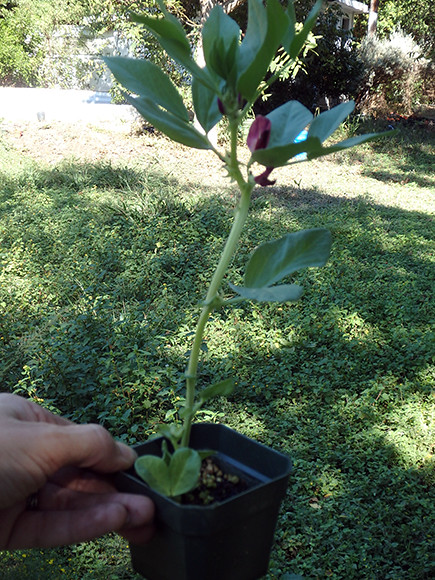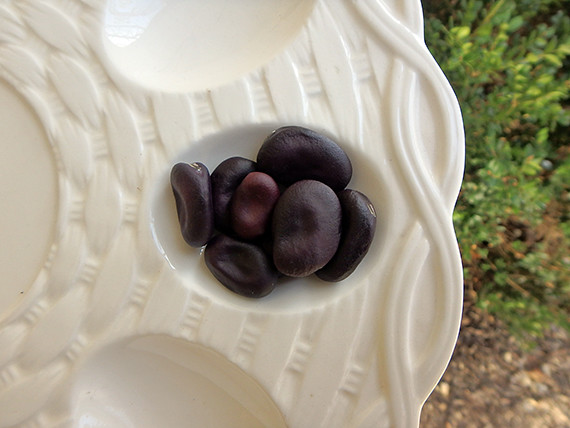|
|
Post by 12540dumont on Jun 8, 2015 23:21:01 GMT -5
Gosh, now I feel lazy. I still have to go harvest my fava seed! I guess that means I can't just leave them in the field and hope they plant themselves for next season? Maybe tomorrow.
|
|
|
|
Post by steev on Jun 8, 2015 23:55:20 GMT -5
Not so much lazy as harried, I'm sure; I also didn't get around to harvesting my favas last week-end, nor did I remember to spread the bunny-bedding; driving out, seeing the bags in the field, it was all "Oh! I forgot to deal with those." Not like they won't be there next week-end, with so much other work; all nattering at me to be done first. Worse than a pack of hungry cats, these garden chores!
|
|
|
|
Post by imgrimmer on Jun 14, 2015 14:21:41 GMT -5
petitvilaincanardyour favas stay very small in comparison to my spring sown crimson flowered favas. Stay autumn sown favas always smaller?
|
|
|
|
Post by petitvilaincanard on Jun 14, 2015 15:01:16 GMT -5
petitvilaincanardyour favas stay very small in comparison to my spring sown crimson flowered favas. Stay autumn sown favas always smaller? Hi imgrimmer, Last year,my 'average'plants were somewhat taller then this year.I can't compare with spring sown favas I didn't do any spring planting for years. But I guess size is a combination of genetic and environmental/climatic factors.(A very safe statement,just to avoid 'I don't know'  ) |
|
|
|
Post by imgrimmer on Jun 14, 2015 15:05:17 GMT -5
 I`ll see what happens next year... |
|
|
|
Post by Joseph Lofthouse on Jun 14, 2015 16:41:14 GMT -5
petitvilaincanard: Thanks for the recent updates about your fava beans. Here's what some of mine look like today. They are about waist high.  These were planted in very early spring as a mix of transplants and direct seeded. Growth wise they currently seem very similar, except that the transplants set much more seed. The direct seeded plants have mostly aborted their flowers. The transplants were flowering at about the same time as the direct seeded plants were getting around to germinating. So the transplants started flowering in much cooler temperatures than the direct seeded plants. A close up from one of the plants that was transplanted: 
|
|
|
|
Post by longhorngardens on Jun 14, 2015 16:53:34 GMT -5
I have grown fava beans for the last two years here in West Virginia. I love them. I had never had them till I ate the ones I grew. I sowed them around St. Patrick's Day both times. I was wondering how they would do for a Fall crop? My first frost is arounf Oct. 20th. I assume I would sow them in August, but I have heard that they won't germinate in heat. It is still real hot in August. So are they strictly a Spring crop for me?
|
|
|
|
Post by Joseph Lofthouse on Jun 14, 2015 17:16:17 GMT -5
The winter hardiness of fava beans is approximately USDA zone 8. So I'm guessing West Virginia would be limited to non-overwintering crops. However, a late summer sowing might result in them flowering and setting seed during the fall.
|
|
|
|
Post by longhorngardens on Jun 15, 2015 0:47:53 GMT -5
Thank you Joseph. I guess I will run a few of them in the Fall just as an experiment.
|
|
|
|
Post by mskrieger on Jul 2, 2015 14:20:52 GMT -5
Joseph, so you transplant favas? Is that worth it for the amount of work? I'd think you'd need to transplant a boatload of plants in order to get a worthwhile amount of beans. How big do you let them grow before you transplant?
I'd have to transplant mine out around St. Patty's day in order for them to set seed before it started getting hot in a typical year. I didn't even try planting them this year. Ironically, it would have been the perfect year to grow them...we've had sustained cool, pleasant temperatures all the way through to today!
|
|
|
|
Post by Joseph Lofthouse on Jul 2, 2015 18:41:39 GMT -5
Transplanting favas is well worth the effort to me. I aim to put three week old plants (about 4" tall) into the ground about the day after the winter snow cover melts. That is about Saint Patrick's Day. This year I tested doing transplants, and direct seeding on the same day. I got little if any fruit set on the plants that were direct seeded It got too hot and they croaked. I got LOTS of seeds from those that went into the ground earlier.
I have a planting system that takes me about 2 seconds per plant, and I can do it while standing up and walking down the row, so transplanting is trivial for me. I start the plants in "6 packs" which are about 1.25" mini pots.
Last year, I had some favas that grew all summer and finally set seed in the fall. I'm intending to try a late summer planting and see if I can select for summer favas as well as spring favas.
Yield on the transplants is about 12 times what went into the ground. So not great, but better than last year, and much better than the year before.
|
|
|
|
Post by steev on Jul 2, 2015 19:16:30 GMT -5
The bulk-bin favas I Spring-planted this year sprouted >99%, but it got too hot too soon to get much more than tender shellies for salads; if the rain comes in November, I'll plant then; I didn't last year because I didn't know the minimum temps would only be 28F, normally they'd be frost-killed in Winter.
|
|
|
|
Post by robertb on Jul 3, 2015 3:33:38 GMT -5
I've tried both direct planting and transplanting, and found that direct planting works better for me. That's not to say transplanting won't work better for some. I used to lose plants when I transplanted, some due to slugs, as they were more vulnerable, and some due to a bacterial(?) rot which turned the roots black. One year pigeons pulled out half my transplants and that was just too much!
|
|
|
|
Post by mskrieger on Jul 6, 2015 12:54:01 GMT -5
Thanks Robert and Joseph. I've tried favas in enough different years here, both spring and fall, to realize that the temperatures change too rapidly from freezing to hot to freezing again for them to grow from direct seeding. But something like 3 weeks could make the difference. I'll try it next year. And pray that the snow really DOES melt by St. Patty's day (I can hear the weather gods laughing now.)
|
|
|
|
Post by flowerweaver on Sept 23, 2015 16:27:03 GMT -5
I sow them in pots and transplant mine, because I start them in the heat of the summer and keep them growing in the shade until it cools off and then I transplant them out in the sun/part shade. My winters are mild enough they overwinter without problem. This year I added more varieties, one was a Welsh fava. Not only did it germinate before any of the others, I have this weird one already blooming!   |
|